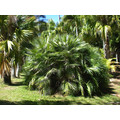Sunlight
Some palms prefer to be under the shade while others welcome the heat. Palms like the Alexandra and the Foxtail like full sun from early age but do well in either condition. Cascades (Chamaedorea cataractarum) and Australia Fans (Licularis ramsayi) like some shade while Kentia's (Howea forsteriana) take time to adjust.
If you're planning to grow palms indoors, check for the types that do well with little sun exposure and can tolerate air-conditioning. The Kentia does well in these environments and can even withstand a little neglect, as do Lady Palms (Rhapis excelsa). Indoor palms benefit from being taken outside every few weeks to receive full sun in order to regain strength.
Consider first how much sunlight you receive all year round in the area where you want to plant your palm.
Water Requirement
There are tropical palms that naturally grow near rivers, lakes and estuaries requiring them to receive plenty of water when cultivated. An example of this would be the Carpentaria Palms and Cascade palms (Chamaedorea cataractarum) whose natural habitat is in banks of creeks and lowland rainforests. Irrigation is heavily needed by this variety in order to grow fully.
There are also palms that are more low maintenance when it comes to water requirements like the Ponytail Palm, which does well in doors. It is highly resistant to droughts and can last up to a month without water. To maintain it though, it would be advisable to mist the leaves to keep from drying, especially if it's humid. Otherwise Cascades like lots of water to look their best.
Soil
In order for your palm to develop fully you need to provide ample soil for its immediate environment.
Soils may be just right or too salty, wet, alkaline, sandy or heavy with clay. The pH of the soil is a measure of its acidity and alkalinity between 0 and 14 with 14 being very alkaline. Most palm species prefer a pH of between 6.4 and 7. With a low pH of 6.0 nitrogen, phosphorous and potassium are lost to the palm. With a pH above 7.0 iron, manganese, boron, copper and zinc are locked out and lost. Adding dolomite or lime to acid soil will make it more alkaline. The best soil to use is a 50/50 blend of your native soil and bought soil made from aged manures, compost and mulch. Plant palms higher in the ground or maybe add some sand in wet or heavy soil. Salty soils need to be drained.
While the soil, water and sunlight requirements are the three major considerations, there are other factors that should be included in your decision when choosing a palm.
First, how involved would you like to be in the palms growth? Some palms like the Cabbage Palm require very little maintenance. Others are fussier like the Chinese Fan Palm. This palm although very pretty as a houseplant, also requires a bit of getting used to. You'll need to observe its water requirements to know for sure how often it likes to be watered.
Also consider the cost of caring for a palm. Most palms require fertilizers in order to grow optimally and some need to be fertilized more often than others.
<< Previous Palms: Solving Brown Tips and Leaf Problems | Back to Mullumbimby Palm Blog | Next >> Playing Horticultural Cupid: The In's and Out's of Pollination



